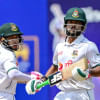Will Bangladesh identify their home advantage?

What is home advantage for Bangladesh? The question has been one of the more acute ones in Bangladesh's Test cricket in the last few years as the team has failed to yield such advantage at home – an outcome pointing to a lack of long-term vision.
More often than not, Bangladesh have suffered at home against big sides in the format despite preparing wickets they thought were more suited to their strengths. Yesterday's four-wicket loss to New Zealand was yet another example.
Following a World Cup debacle, the cricket board was keen to sweep disastrous performances in India under the rug and a Test series win felt like the perfect remedy for the incumbent board. While a 150-run win in Sylhet in the first Test showed that the team is ready for conditions that has a bit for everyone, the wicket served up in Mirpur went back to the particular blueprint of 2016 and 2017 from head coach Chandika Hathurusingha's first stint. The only problem with that is that more often than not, the blueprint of success that had led to wins against England and Australia on such tracks, is one that usually backfires on the Tigers.
This time, too, Bangladesh banked on their spinners to bowl better than their counterparts, which they possibly did. However, the Bangladesh batters had a harder time than their Kiwi counterparts which resulted in another Test loss and an opportunity to seal a historic series let go.
Even the crowd in Mirpur yesterday was talking about the pitch. The first ball from Shoriful Islam just shaped away and once it landed, it rolled to the wicket-keeper. The BCB president Nazmul Hassan, speaking after the match, suggested that they expected the team to play better on such a wicket.
Captain Najmul Hossain Shanto said the home advantage factor did not backfire on them.
"I don't think so. When we play Tests, we are not here to improve. This is not a place for practice. We are trying to win the Test. It is important that we prepare to win the Test. But we should definitely take this type of advantage. We can prepare in first-class cricket by trying out good wickets or wickets like these," he said at the press conference yesterday, even though the way second Test played out suggested that the home advantage has been misinterpreted.
While India or Sri Lanka also produce turning tracks, usually the pitches have true bounce. At Mirpur, balls often bounced so low that most batters worried about when one was sneaking through under the bat or other times they took off from a length. Success for batters, appeared to be decided by chance or fate.
Would the batters carry confidence when they move to New Zealand for the ODI and T20I series? They would again need to acclimatise to true bounce, always lagging behind the rest of the world.
"There was both turn and bounce. It was difficult for the batters. We have to enjoy these challenges as batters. We wanted this wicket. As a batting group, it was important how we could have taken the team forward on the strength of big partnerships. I hope batters will enjoy these conditions in future," Shanto said when asked whether the uneven bounce was more difficult than the turn spinners enjoyed.
Thus, having suffered a World Cup debacle where the batters failed to capitalise on sporting wickets, this time the Bangladesh think-tank outwitted the Test team as well.

 For all latest news, follow The Daily Star's Google News channel.
For all latest news, follow The Daily Star's Google News channel. 








Comments